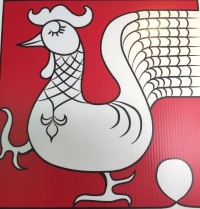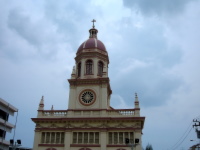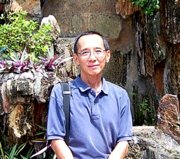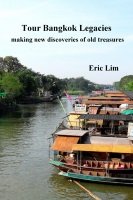- Home
- Bangkok Museums
- Portuguese Embassy Bangkok
Portuguese Embassy Bangkok
the first diplomatic
mission
By Eric Lim
The Portuguese Embassy Bangkok is the oldest diplomatic mission in Thailand and represents 500 years of friendship and 200 years of diplomatic relations between the two countries.
Though it's not a museum, there is so much history associated with this building that I've included this subject as a special feature article under the heading of Bangkok Museums.
The photographs used in this article were taken from a photographic exhibition organised by the Portuguese Embassy Bangkok to show 40 rare photographs of views inside and outside the embassy building and its grounds. Some of these photographs were taken in the early 20th C.
This exhibition was held in ICONSIAM, a mall in Bangkok from 2 - 20 December 2020 to commemorate 200 years of diplomatic relations between the two countries.
The photographs from this exhibition were taken by Joachim Antonio, a Portuguese photographer in the early 20th C and several Thai photographers as well. I have included the names of the photographers with the photos they took when this information is available.
If not for this exhibition, many of us would not have a chance to see such close-up views of this historic building and within it.
The photographs in the section "The Portuguese in Asia" are taken from the Baan Kudichin Museum.
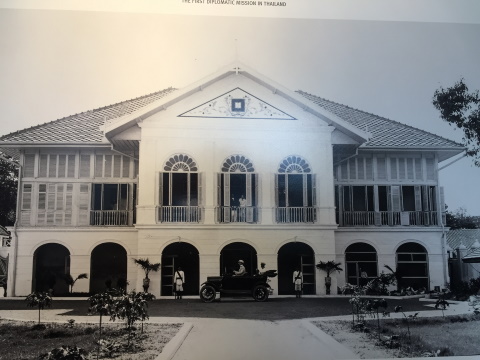
Ambassador's Residence, Portuguese Embassy Bangkok 1918
The Portuguese in Asia
The Portuguese were the first Europeans to arrive in Asia. In the 15th and 16th C intrepid Portuguese mariners sailed their ships to India, Brazil, South-east Asia, China and Japan. This was the Age of Discovery.
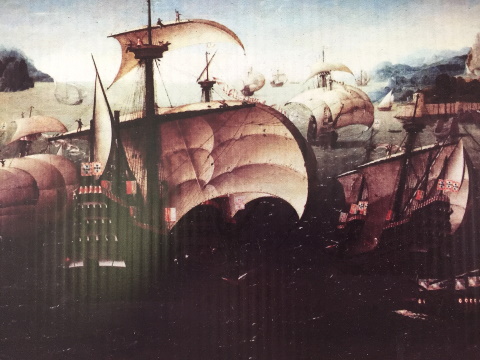
Portuguese galleons that sailed the high seas – courtesy of Baan Kudichin Museum
The first to blaze the way was Vasco da Gama, a Portuguese navigator, mariner and explorer. Da Gama set sail from Portugal in 1497, sailed southwards on the Atlantic, rounded the Cape of Good Hope, crossed the Indian Ocean and arrived in India in 1498.
This journey established the route from Europe to India and later the rest of Asia. It was to be the route taken by other imperialist powers to lay their claims to large parts of Asia.
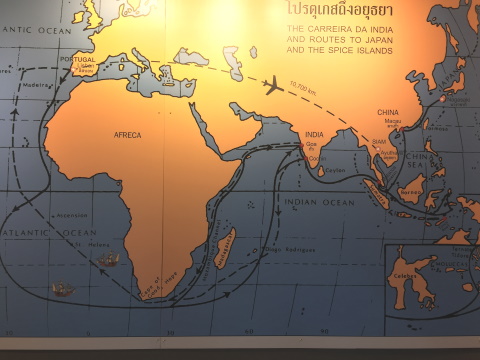
World map showing the sea routes used by the Portuguese to reach India and the Far East – courtesy of Baan Kudichin Museum
Afonso de Albuquerque, a soldier followed in da Gama's wake. De Albuquerque's strategy was to gain control of the maritime trade route to the East by building a string of coastal fortresses along the route.
De Albuquerque captured Goa in India in 1510 and Malacca in the Malay Peninsula in 1511 to secure the supply of spices from the Spice Islands*.
*Known as Moluccas or East Indies back then and called Maluku Islands in Indonesia today.
After the capture of Malacca in 1511, the Portuguese sent an envoy Duarte Fernandes with gifts to the King of Ayutthaya to assure the king that the Portuguese were interested in trade and had no military intentions on Ayutthaya.
After an exchange of gifts and two more envoys from Portugal, a treaty was signed in 1516. Under the terms of this treaty, the Portuguese could set up a trading post in Ayutthaya. The treaty included the provision of muskets, cannon, gunpowder and mercenaries in service of the King of Ayutthaya.
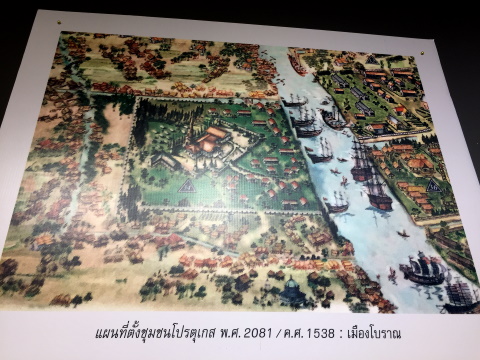
Map of Portuguese Village just south of the old city of Ayutthaya including the trading post and a church, the Dominican Church of San Pedro 1583 – courtesy of Baan Kudichin Museum
The ruins of the church can be viewed in this article Ayutthaya from the ashes of destruction
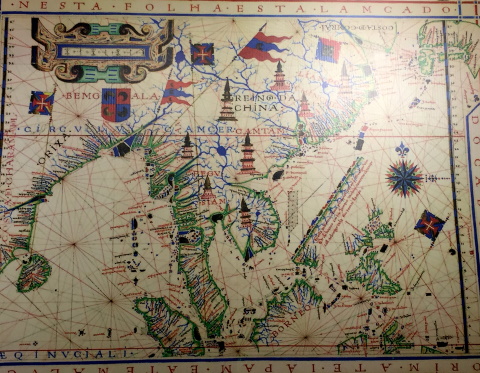
Old Portuguese map of South East Asia 1575 – courtesy of Baan Kudichin Museum
However, true to the tradition of the second oldest profession in the world, the Portuguese also provided arms and mercenaries to Burma who was at war with Siam then.
For more on the Portuguese legacy in Bangkok, please see Baan Kudichin Museum
Diplomatic Relations with Siam
On 9 November 1820, King Rama II granted land to the Portuguese for a trading post just 300m south of the Holy Rosary Church. Also established on this plot of land was the Consulate of Portugal in a wooden building with Carlos Manoel da Silveira as Consul-General.
In 1860 work commenced a concrete building as the Ambassador's Residence. This building was completed 1875. The building was renovated in the early 20th C.
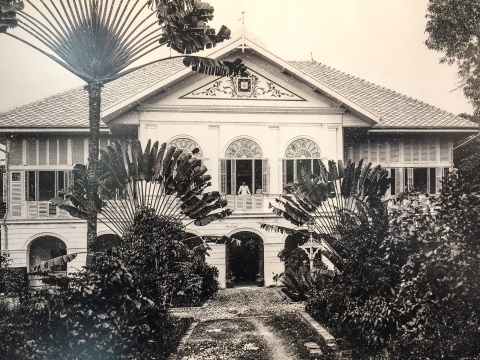
A beautiful black and white photo of the Ambassador's Residence, Portuguese Embassy Bangkok by Joachim Antonio early 20th C
Portuguese Embassy Bangkok - Review of Photos
Here's a review of some rare photographs of the Portuguese Embassy Bangkok, covering the grounds, outside and inside the Ambassador's Residence. This gives us a chance to appreciate the architecture of the building. These are views many of us will rarely have the chance to actually see.
We start with a wonderful shot with a bird's eye view of a beautifully lit Ambassador's Residence taken from a high point directly across the river. This can only be the ICONSIAM, the latest mega mall in Bangkok that's directly across the Chao Phraya from the Portuguese Embassy.
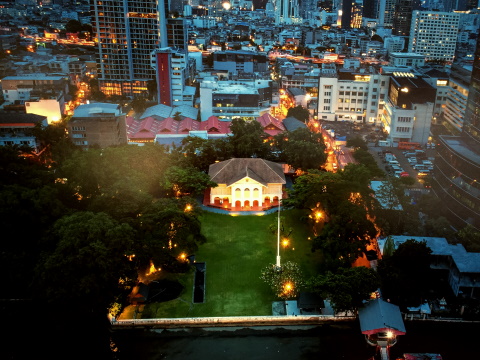
A beautifully lit view of the embassy grounds and the Ambassador's Residence
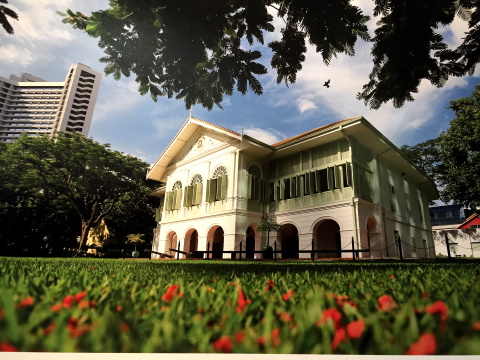
Another shot of the residence taken at ground level
The façade of the Ambassador's Residence displays the coat of arms of Portugal with a crown above. This was actually the old coat of arms when Portugal was a monarchy until 1910.
On 5 October 1910, an uprising by military officers overthrew the monarchy ad declared a republic. The current coat of arms of Portugal has no crown above. The Portuguese Embassy Bangkok has retained the crown in the coat of arms for the Ambassador's Residence in Bangkok.
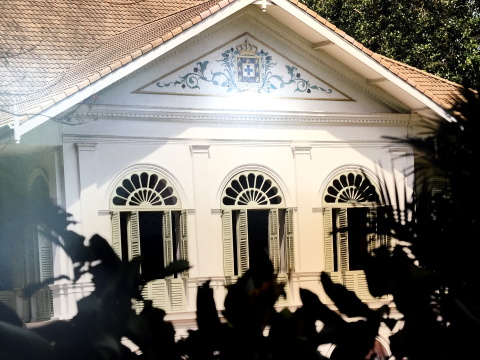
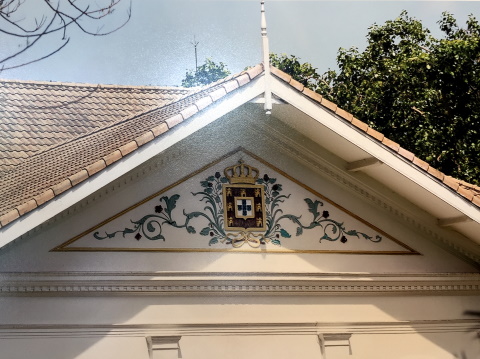
Coat of arms of Portugal on the façade of the Residence just below the roof – by Banharn Linthong
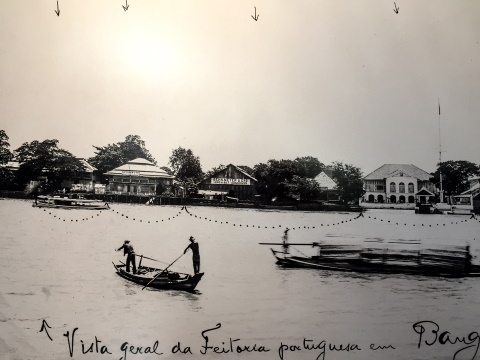
View of the Portuguese Embassy Bangkok from across the river in Thonburi 1918
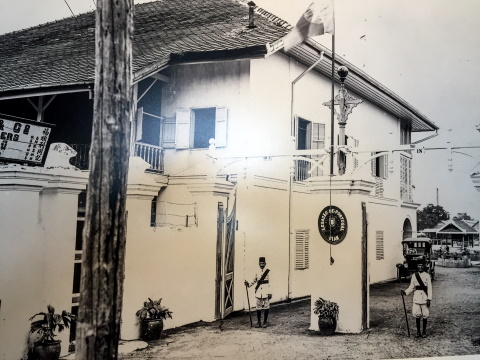
Guards on duty at the former main gate to the consulate to rear of the Residence 1918. In those days, the main gate of buildings faced the river as water transport was the main means of movement. With road transport, the side of buildings facing the river has become the rear.
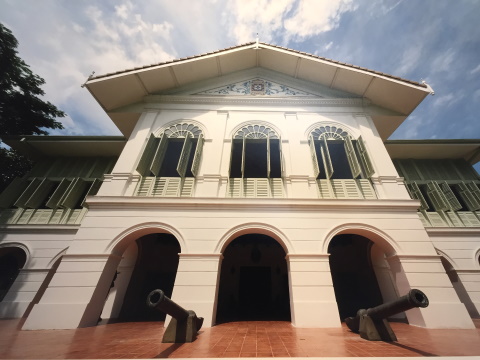
Spectacular view of the front entrance to the Residence - by Wisarn Phongwilas
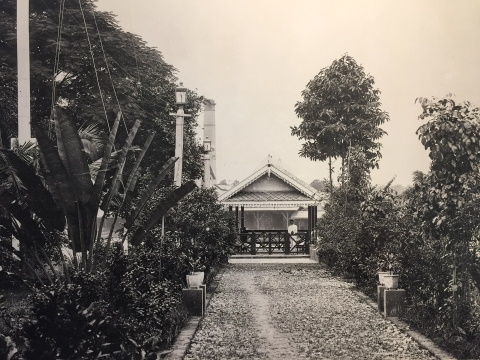
Garden path leading to the pier on the Chao Phraya - by Joachim Antonio early 20th C
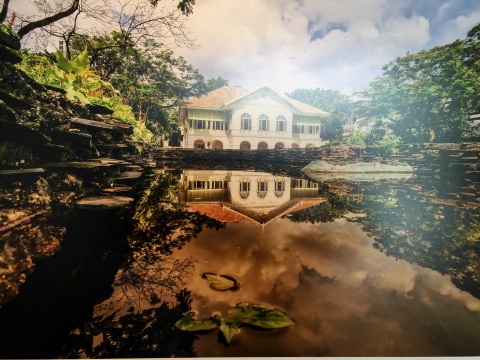
Reflections
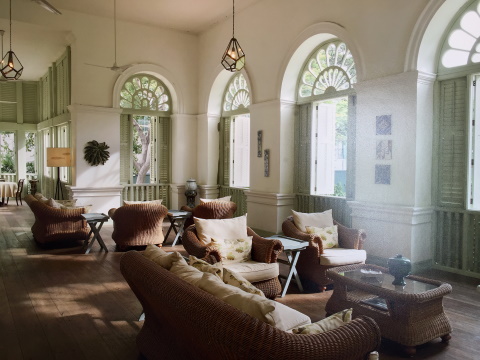
The charming front veranda in the Residence facing the Chao Phraya. It's decorated with Portuguese ceramic art - by Naphat Ratanasakdi
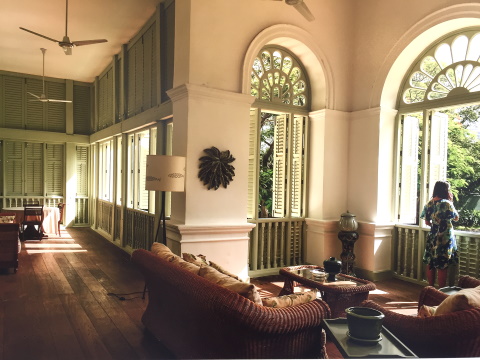
Another shot of the veranda from the same angle but in a different light - by Banharn Linthong
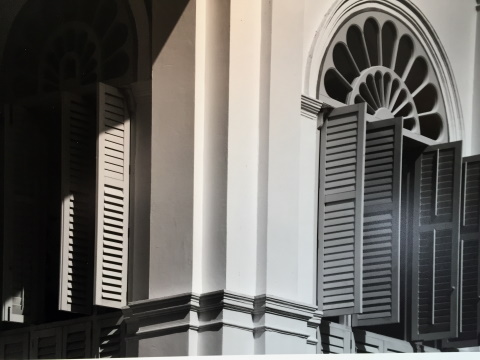
Arched or peacock windows in the front veranda of the Residence
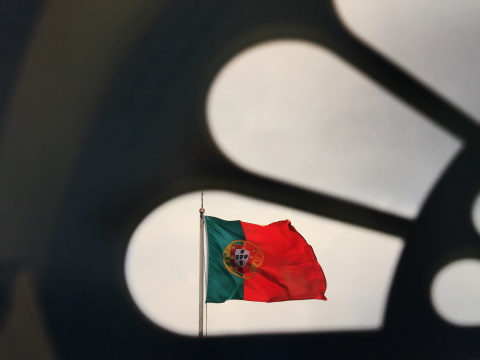
Portuguese flag in front of the Residence, the flag pole dates back to 1876 - by Chawan Sirimanatorn
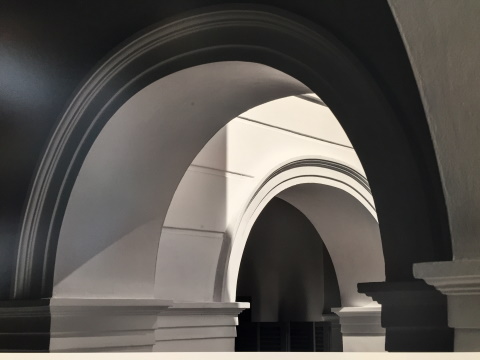
Three sets of arches, of three each along the open area along the façade of the Residence
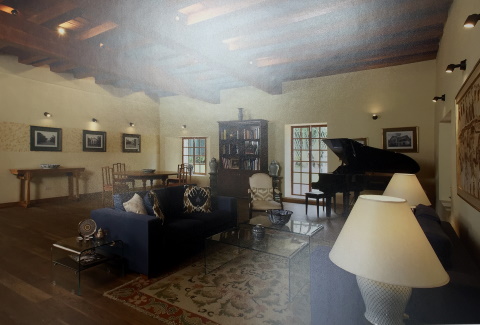
Reception room on the ground floor of the Residence where concerts, plays and meetings are hosted – by Naphat Ratanasakdi
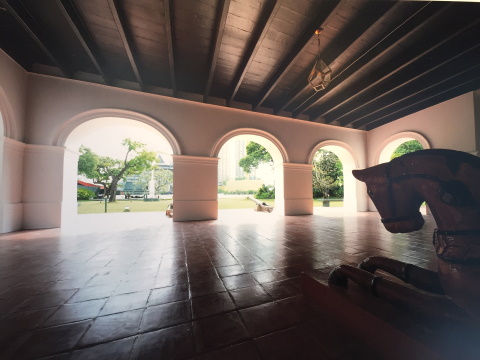
View of the garden from the front entrance looking through the arches – by Sompoch Tangthai
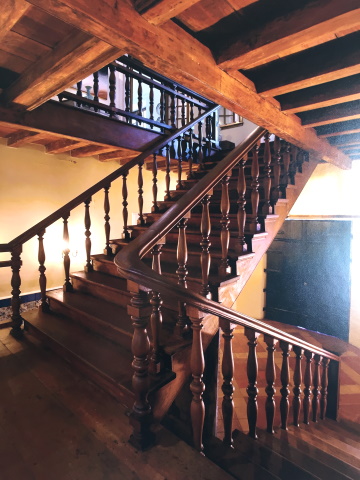
Original teak staircase – by Naphat Ratanasakdi
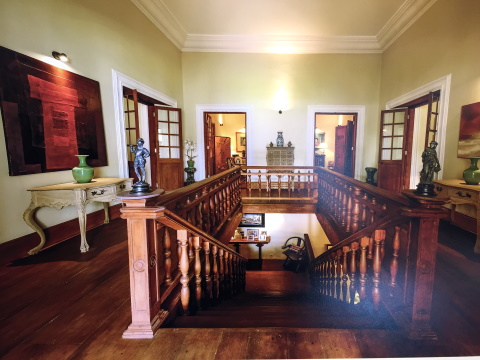
Upstairs, note the exquisite woodwork – by Wisarn Phongwilas
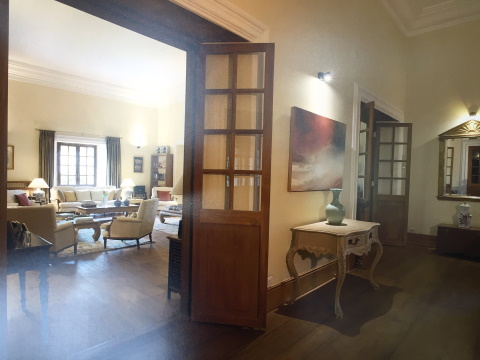
The main reception room upstairs where visiting dignitaries and guests are received. I was surprised to learn that the Portuguese word for living or reception room is "sala". – by Naphat Ratanasakdi
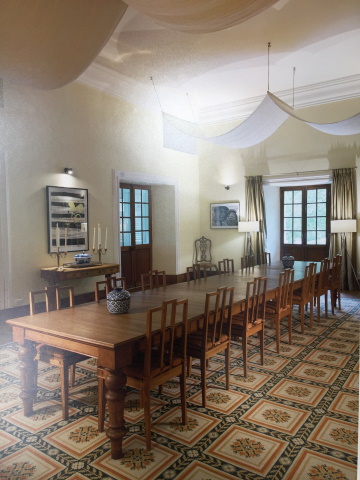
The elegant dining room – by Naphat Ratanasakdi
We have just completed a virtual tour of the Ambassador's Residence. Let's take a look at some of other beautiful shots taken by these talented photographers.
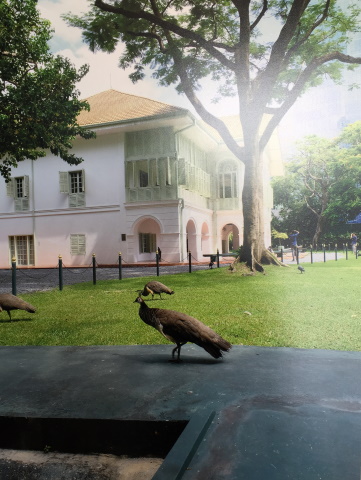
Some peacocks making themselves at home in the Embassy grounds – by Jirawat Jangjan Ratanasakdi
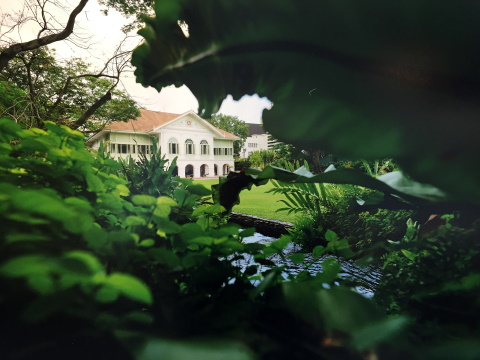
A shot from the trees – by Wirawit Thitiworasith
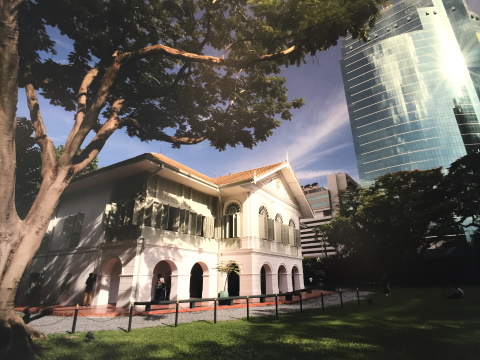
The old and the new, the Communication Authority of Thailand (CAT) Tower and the Ambassador's Residence– by Kitiporn Saekong
Who was Captain Bush?
Right from the beginning, the Portuguese Embassy Bangkok was located in Soi Charoen Krung 30. This soi or lane is also known as Soi Captain Bush. Who was Captain Bush?
Captain John Bush (1819 - 1905), later Admiral Sir John Bush, was an English sea captain who arrived in Bangkok in 1857 in the reign of King Rama IV. This was two years after the signing of the Bowring Treaty which opened up Thailand to international trade.
Captain Bush was appointed by King Rama IV as Harbour Master to restore order to the busy shipping that was sailing into Bangkok port, a post he held this post for 30 years
In 1865 he established the Bangkok Dock Company Limited, an engineering and shipping company.
Captain Bush's home was in House no. 1 Soi Charoen Krung 30 just opposite where the Royal Orchid Sheraton Hotel is currently located. This was a soi where several expatriates in Bangkok made their homes.
House no 1 has been restored and designated a historical building. Soi Charoen Krung 30 became popularly known as Soi Captain Bush.
A chance encounter
I first saw on the Ambassador's Residence, Portuguese Embassy Bangkok back in 2007. It was a chance encounter as I was passing by on a Chao Phraya River boat.
When the grand old building caught my eye, I didn't know what it was until I saw the Portuguese flag flying in the grounds. Back then, I never imagined that one day, thirteen years later I would have the chance to view photographs of the Residence both of the exterior and interior at such close range.
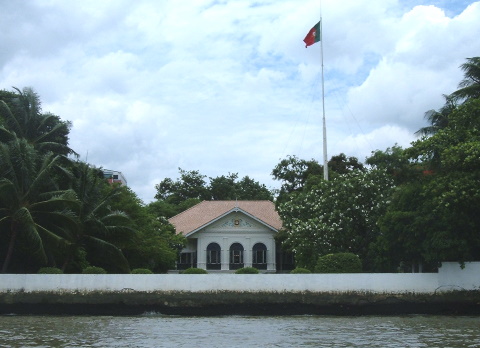
A chance encounter by the author in 2007
Map to the Portuguese Embassy Bangkok
Or click on this link to view the map to the Portuguese Embassy Bangkok
Address
Embassy of Portugal
26 Soi Charoen Krung 30 (Soi Captain Bush)
Bang Rak
Bangkok 10500
How to get there
Here are two quick ways of getting to the Portuguese Embassy Bangkok.
You could take the Green Line (BTS Sky Train Silom Line) and alight at the S6 Saphan Taksin Station. From there take a walk along Charoen Krung Road to Soi Charoen Krung 30. With the heavy traffic there, it's faster walking. The distance is about 1.3 km.
Alternatively, take a Chao Phraya River boat to the N3 Si Phraya Pier which is just north of the embassy. Walk straight out from the pier to Soi Charoen Krung 30 and turn right to get to the embassy.
Contact
Tel:
66 (0) 2234 2123
66 (0) 2234 0372
Website: https://banguecoque.embaixadaportugal.mne.gov.pt/en/
Facebook: https://www.facebook.com/Embaixada-de-Portugal-em-Banguecoque-1212925715390010/
How to get there
Opening times
Mondays – Fridays 0830 – 1230 hours, 1330 – 1630 hours
Consular public counter: Mondays – Fridays 0830 – 1230 hours
For more Bangkok Museums.
Related pages on the Portuguese in Thailand
My Journey through Thailand Part I The First Steps
This is my second e-book and the first in the series of travel journals on my trips to explore the various provinces in Thailand. This edition, which covers my travels from late 2009 to mid-2013, will guide you to historical sites, cultural monuments and exquisite Thai handicraft, across a vast spectrum of cultural and ethnic diversity.
You can have a virtual tour with this e-guide book or take the first steps yourself in this journey through Thailand.
My Kindle e-book

Search Tour Bangkok Legacies with DuckDuckGo
